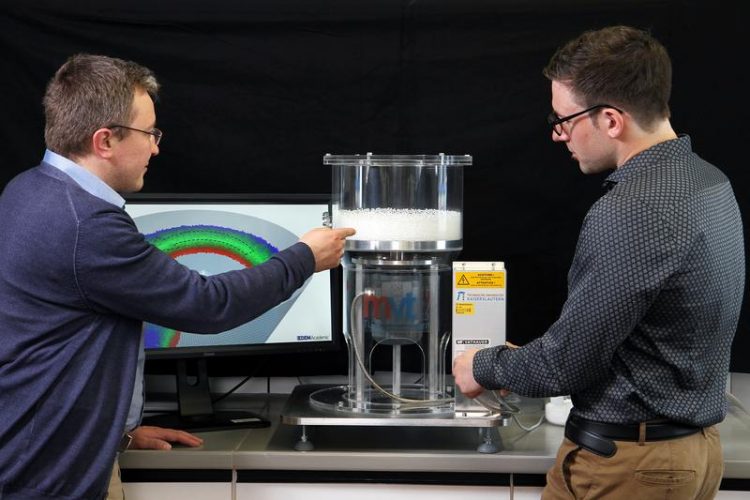Achema 2018: Researchers improve globule formation for pharmaceutical capsules

The researchers are working to improve this process and are investigating the parameters that might support globule formation. Credit: TUK/Thomas Koziel
During the Achema, a trade fair for the process industries in Frankfurt, they are presenting this technology at the research stand of the federal state Rhineland-Palatinate from June 11-15 (hall 9.2, stand A86a).
Mostly, pharmacies sell medication in the form of capsules which contain many tiny globules. The original substance has the form of cylindrical pellets which consist of different small particles. In order to be able to use them in medication they first need some treatment.
Professor Dr. Sergiy Antonyuk, Head of the Institute of Particle Process Engineering of the TUK, explains that the globule form is advantageous for two reasons: “The same globules always contain the same amount of active substance. Also the size of the sphere surface plays an important role during production.”
This is because before the globules are filled into a capsule, they are treated with a special coating. “This makes them resistant against gastric acid or it helps the globules to have their full effect only after a certain period of time”, explains Professor Antonyuk. This makes it easier for the industry to exactly calculate how much globules they have to use.
In order to produce the globules, the industry uses a spheronizer. Even the Universität Kaiserslautern is using such an apparatus. Researchers are currently investigating on how to further improve the formation of the globules. The technology is similar to a salad spinner or a rotating bowl. The specialty is the rough surface of the spheronizer's base.
“These small pyramid-like elevations cause high friction and finally make sure that the pellets, technically also called extrudates, are formed to globules within about 15 minutes”, explains Dominik Weis, doing research in this project which is subsidized by the German Research Foundation, within the scope of his PhD thesis. This apparatus is spinning with a rate of between 1200 and 1600rpm. “This can be individually adjusted”, explains Denis Goldnik, who is also involved in this project.
The researchers want to find out how the parameters need to be set for this procedure to have an optimized process producing less material wastage and consuming less energy. “We not only use laboratory tests but also computer simulation which is ideal to simulate different situations by varying parameters such as speed and degree of filling”, Goldnik continues.
The engineers of the Department Mechanical and Process Engineering in Kaiserslautern work closely with colleagues around Professor Dr. Markus Thommes of the University of Dortmund, who provide the starting material for their experiments as well as experimental data for simulations. The project is subsidized by the German Research Foundation.
At the Achema, researchers of the TU Kaiserslautern are presenting their project as well as a spheronizer.
Questions can be directed to:
Prof. Sergiy Antonyuk
Phone: +49 (0) 631 205-3524
Email: sergiy.antonyuk(at)mv.uni-kl.de
Klaus Dosch, Department of Technology and Innovation, is organizing the presentation of the researchers of the TU Kaiserslautern at the fair. He is the contact partner for companies and, among other things, establishes contacts to science.
Contact: Klaus Dosch, Email: dosch[at]rti.uni-kl.de, Phone (also during the fair): +49 (0) 631 205-3001
Media Contact
More Information:
http://www.uni-kl.deAll latest news from the category: Trade Fair News
Newest articles

A universal framework for spatial biology
SpatialData is a freely accessible tool to unify and integrate data from different omics technologies accounting for spatial information, which can provide holistic insights into health and disease. Biological processes…

How complex biological processes arise
A $20 million grant from the U.S. National Science Foundation (NSF) will support the establishment and operation of the National Synthesis Center for Emergence in the Molecular and Cellular Sciences (NCEMS) at…

Airborne single-photon lidar system achieves high-resolution 3D imaging
Compact, low-power system opens doors for photon-efficient drone and satellite-based environmental monitoring and mapping. Researchers have developed a compact and lightweight single-photon airborne lidar system that can acquire high-resolution 3D…





















